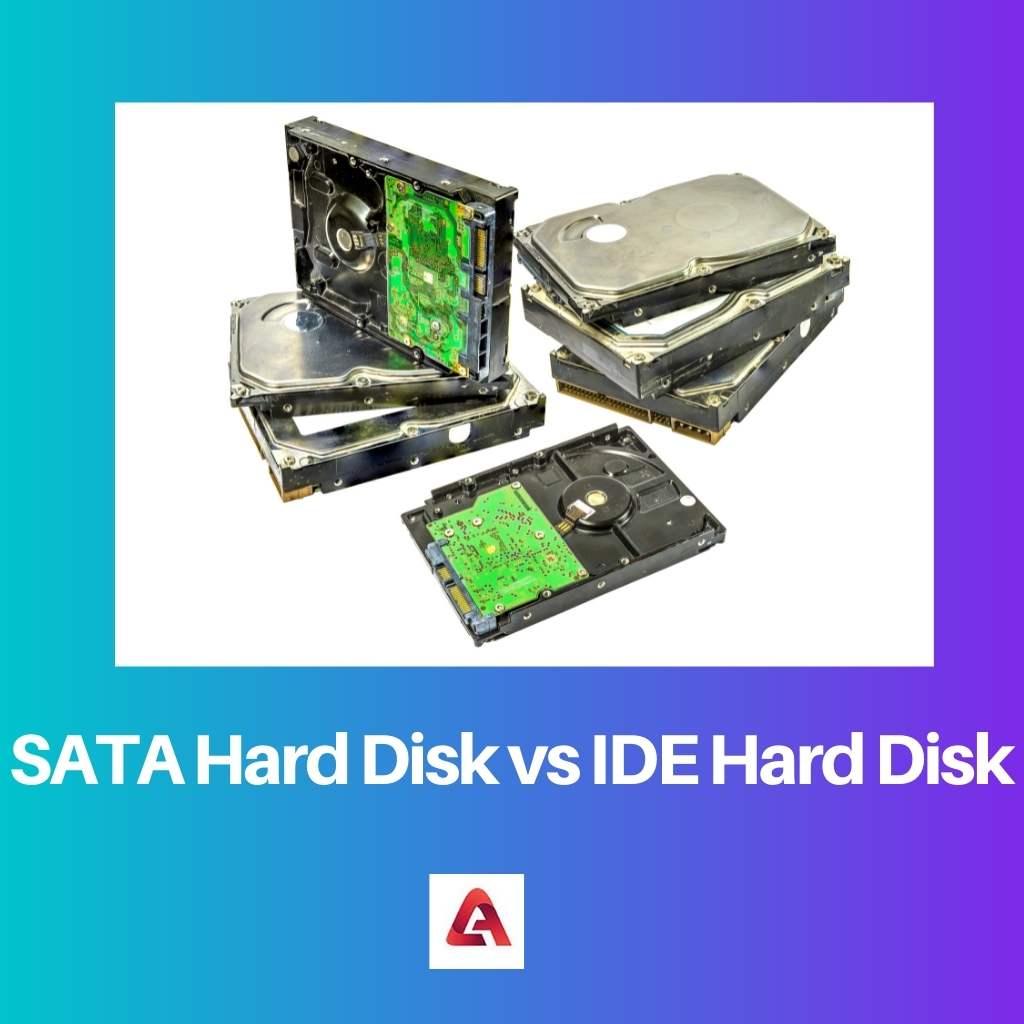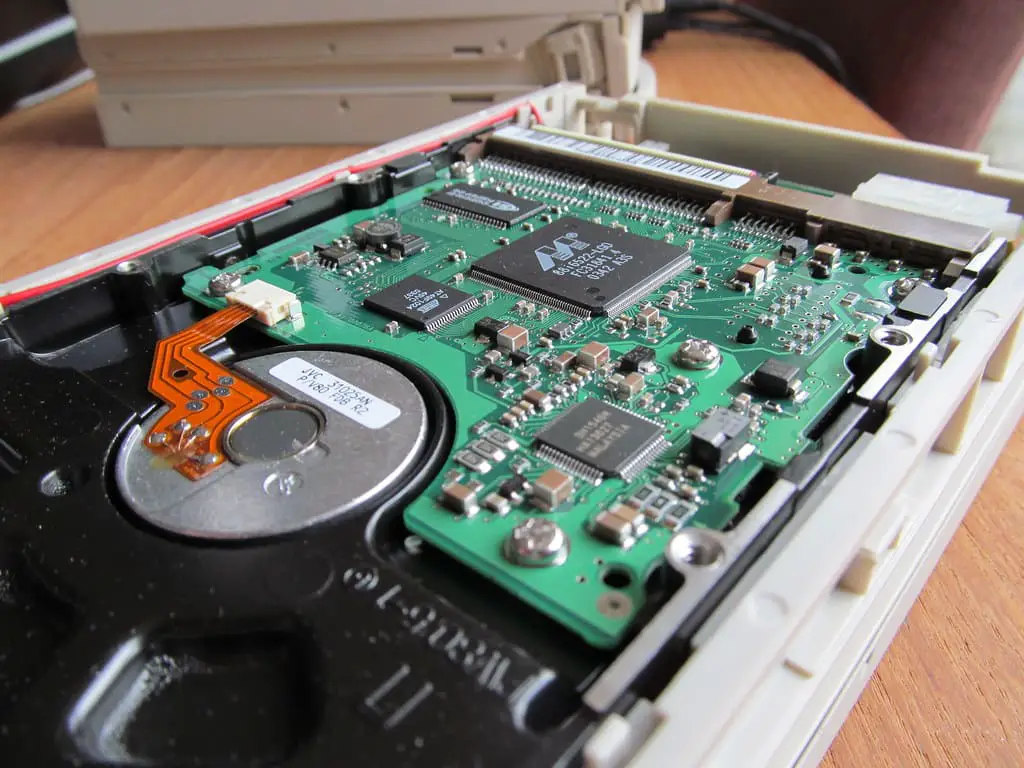Hard disks are the data storing units; hence, they are an integral part of the computer, without which the system cannot operate since the continuous development of computers.
Throughout the years, hard disks also needed to evolve to cope up with new technology. There have been many types of hard disks till now, two of which are SATA and IDE hard disks.
Key Takeaways
- Serial ATA (SATA) and Integrated Drive Electronics (IDE) are different interfaces that connect storage devices to a computer’s motherboard.
- SATA offers faster data transfer speeds, better performance, and supports hot-swapping, while IDE has slower transfer speeds and is an older technology.
- IDE uses a wide ribbon cable for connections, whereas SATA employs a smaller, more flexible cable, allowing for better airflow and cable management.
SATA Hard Disk vs IDE Hard Disk
IDE is a wide ribbon cable with 40 or 80 pins that connects the hard disk to the motherboard, with two devices per cable. SATA is the most commonly used interface for hard drives, providing faster data transfer rates and hot-swapping, allowing hard drives to be removed and replaced without shutting down the computer.

SATA hard disk is a rewritable mass storage device with excellent transmission speeds and large storage capacities. And is compatible with all operating systems and computer motherboards.
Not only in computers and laptops, but SATA hard disks are also compatible with video gaming consoles. Including the PlayStation 4, Xbox 360, etc.
IDE hard disk is a hard disk that was earlier used in computer systems that required both reliable and non-volatile data storage types. These hard disks are the easiest to install drives into the system.
By removing the difficulties with the division of the components and controllers. IDE was a major upgrade from its predecessor.
Comparison Table
| Parameters of Comparison | SATA Hard Disk | IDE Hard Disk |
|---|---|---|
| Stands for | SATA is an abbreviation of Serial Advanced Technology Attachment. | IDE is an abbreviation for Integrated Drive Electronics. |
| Year Created | 2003 | 1986 |
| Capacity | It has a maximum capacity of 16TB | It has a maximum capacity of 1TB |
| Data Transfer Speed | Data transfer rate up to 6 Gbps. | Data transfer rate up to 133 Mbps. |
| Hot-Plugging | Supports hot-plugging. | Does not support hot-plugging. |
What is SATA Hard Disk?
SATA stands for Serial Advanced Technology Attachment. SATA hard disk is a rewritable mass storage device with excellent data transfer speeds and large storage capacities.
And is compatible with all operating systems, including Windows, Kali Linux, etc., and various motherboards. SATA hard disks are reliable for approximately 3 to 4 years at maximum.
Introduced in 2003, SATA is the pre-installed interface for almost all computer laptop hard disks. A SATA hard disk, when launched, was exceptionally faster as compared to its predecessor.
A SATA hard disk can write to the disk with a maximum interface data transfer rate of 6 Gb/s. This hard disk has a capacity ranging from 500 GB to 16 TB.
SATA hard disks are also hot-pluggable, which means the user can remove them. Or attach drives without having to shut the whole system down.
One major con of SATA hard disks is that they require regular de-fragmentation. Since its launch in 2003, six revisions of SATA hard disks have been made.
SATA Revision 3.3, the latest SATA hard disk, was launched in the year 2016. This build offered many upgrades and new features, including SMR support, transmitter emphasis, power disables, etc.

What is IDE Hard Disk?
IDE stands for Integrated Drive Electronics. IDE hard disks were launched in 1986 by a company named Western Digital.
They are relatively slow by today’s standards. They have a maximum data transfer speed of up to 133 Mbps and a maximum capacity of 1 TB.
IDE hard disk is connected to the computer’s data bus via the IDE interface. These hard disks are now outdated in today’s technology.
IDE hard disks are different from other hard disks because their controllers are on each drive, which means that the hard disk is directly connected to the system’s motherboard or the controller.
IDE hard disks are very easy to install and need no technical help. The data on IDE hard disks need to be regularly backed up as they can crash on extensive loads.
They have less speed and inferior overall performance by today’s standards of hard disks. Users are also more prone to electrical shocks with these hard disks as hot-plugging is not available in IDE.
When SATA hard disks completely took over the market in 2007, the production of IDE hard disks stopped as they were not comparable to SATA.
With SATA offering better performance. IDE hard disks are now outdated.

Main Differences Between SATA and IDE Hard Disk
- SATA hard disk has 8TB of maximum capacity, and IDE Hard Disk has 1TB. Hence, SATA can store 8 times more data than IDE.
- Data transfer speed in SATA hard disk can go up to 6 Gbps, whereas IDE hard disk can only go up to 133 Mbps, which is relatively slow.
- SATA hard disks are sold in large numbers, whereas IDE hard disks stopped manufacturing in 2007.
- SATA hard disk configuration is complex for most people, whereas IDE hard disks have a rather simpler configuration.
- SATA cables have increased airflow as compared to IDE cables. As a result, less heat is developed in the motherboard.

Finally, an article that explains the intricacies of SATA and IDE hard disks in a clear, no-nonsense manner. Thank you!
Spot-on, Martin. Couldn’t have said it better myself.
An interesting take on the evolution of hard disks. I learned a lot, thank you!
Agreed, very informative!
I was looking for an article that would go beyond the basics of SATA and IDE. Unfortunately, this was not it.
Great article, very informative. I particularly appreciated the in-depth comparison tables, which makes the decision of which hard drive to buy so much easier.
You said it Graham! The comparison tables were very enlightening.
I found the historical context of SATA and IDE hard disks fascinating, although I think more emphasis could be placed on the practical applications of each.
Not too impressed. The article seemed to be stating the obvious, not much new information here.
The technical details provided are very useful. It’s great to see such detailed information laid out in a clear manner.
The technology behind hard disks can be difficult to understand sometimes, so thank you for breaking it down so well.
Absolutely, Grant. It’s much appreciated.